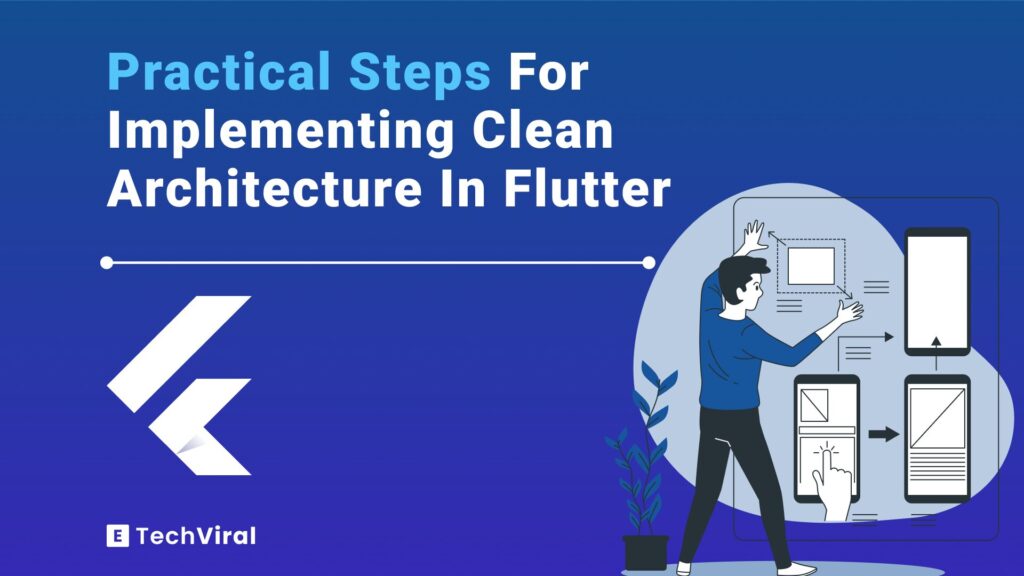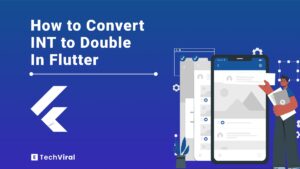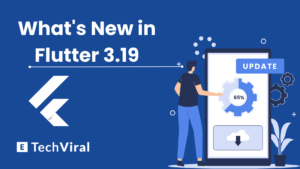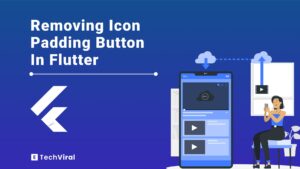In this step by step guide, we delve into implementing clean architecture in Flutter, a crucial step for structuring scalable and maintainable apps. We’ll integrate Firebase for a real-world application scenario, enhancing both learning and practicality.
Starting from setting up a new Flutter project, we’ll meticulously organize our work according to clean architecture layers. Each step, from domain to presentation, will be aligned with Firebase integration, ensuring a comprehensive understanding.
By the end, you’ll not only grasp clean architecture in Flutter but also how to effectively synchronize it with Firebase, a skillset highly valued in modern app development.
How To Implement Clean Architecture In Flutter
If you want to learn flutter app development we created a free Flutter firebase bootcamp, In this course you will learn step by step process to make an application using clean architecture from scratch.
In Flutter app development, clean architecture is achieved by organizing the application into three distinct layers for optimal structure and efficiency. These include the Presentation Layer for user interface management, the Domain Layer for business logic, and the Data Layer for data processing and storage.
Here’s the Step by step practical process to implement clean architecture in Flutter:
10 Practical Steps for Implementing Clean Architecture In Flutter
Step 1: Create a New Flutter Application
Step 1.1: Installing Flutter
Before creating a new Flutter application, ensure you have Flutter installed on your system. If not, download and install Flutter from the official website.
Follow the installation guide specific to your operating system (Windows, macOS, or Linux).
Step 1.2: Creating the Project
1.2.1 Open your Terminal or Command Prompt.
- Navigate to the directory where you want to create your new Flutter project.
1.2.2: Run the following command:
flutter create clean_arch_flutter
- This command creates a new Flutter project named ‘clean_arch_flutter’.
1.2.3: Navigate to your project directory:
cd clean_arch_flutter
1.2.4: Open the project in your preferred IDE.
- For Visual Studio Code, you can run code . in the terminal while in the project directory.
- For other IDEs, open them normally and navigate to your project folder.
Step 1.3: Exploring the Default Project Structure
Upon creating a new Flutter project, you’ll notice several files and directories:
- lib/: The main directory where you’ll write most of your Dart code.
- pubspec.yaml: This file manages your project’s dependencies.
- test/: Directory for writing test cases.
- android/ and ios/: These directories contain platform-specific files for Android and iOS, respectively.
Step1.4: Running the App
1.4.1: Ensure you have an emulator running or a device connected
- You can start an Android emulator via Android Studio or connect a physical device with USB debugging enabled.
1.4.2: Run the app
- In the terminal, execute:
flutter run
- This command compiles the app and launches it on the connected device or emulator.
1.4.3: View the default starter app
- Upon running, you’ll see the default Flutter starter app. This is a simple counter application.
Now you’ve successfully set up and run a new Flutter project. This forms the foundation upon which we’ll build our application using clean architecture, and later integrate Firebase for enhanced functionality.
Step 2: Set Up Required Folders and Files
After setting up your new Flutter project, the next step is to organize it according to the clean architecture pattern. This involves creating a specific folder structure that separates the app’s concerns into ‘data’, ‘domain’, and ‘presentation’ layers.
Step 2.1: Creating the Folder Structure
2.1.1: Open your project in your IDE
- Navigate to the lib/ directory of your Flutter project.
2.1.2: Create three main directories:
- domain/: This will contain all your business logic, including entities and use cases.
- data/: This directory will house your data models, data sources, and repositories.
- presentation/: This is where your UI components like screens and widgets will reside.
Here’s how to create these directories in your terminal:
cd lib/ mkdir domain data presentation
Step 2.2: Setting Up the Domain Layer
2.2.1: Inside the domain/ directory, create subdirectories:
- entities/: For defining the core business objects of your application.
- usecases/: To store your business logic operations.
- repositories/: For abstract repository interfaces.
Use these commands:
cd domain mkdir entities usecases repositories cd ..
Step 2.3: Organizing the Data Layer
2.3.1: In the data/ directory, create these subdirectories:
- models/: For data models, especially those representing API responses and database entities.
- datasources/: To manage different data sources like remote (API) and local (database).
- repositories_impl/: For concrete implementations of the repositories in clean architecture, defined in the domain layer.
Execute these commands:
cd data mkdir models datasources repositories_impl cd ..
Step 2.4: Structuring the Presentation Layer
2.4.1: Within the presentation/ directory, consider these subdirectories:
- screens/: For different screens of your app.
- widgets/: For custom widgets used across different screens.
- bloc/ or viewmodel/: Depending on your state management choice, for managing the state of UI components.
Create them using:
cd presentation mkdir screens widgets bloc cd ..
With this structure, your Flutter project is now neatly organized, reflecting the clean architecture pattern. This setup not only makes your codebase cleaner and more manageable but also sets a solid foundation for building scalable and maintainable Flutter applications.
Next, we will dive into the specifics of implementing each layer, starting with the domain layer.
Step 3: Implementing the Domain Layer
The domain layer serves as the core of your Flutter application, containing business logic, entities, and abstract definitions of repositories. It’s framework-independent and should not rely on any libraries used in the data or presentation layers.
Step 3.1: Defining Entities
3.1.1: Navigate to the domain/entities directory.
3.1.2: Create Dart files for each entity.
- For example, if your app manages tasks, create a file named task.dart.
- In task.dart, define a class Task with necessary properties:
class Task {
final int id;
final String title;
final String description;
final bool isCompleted;
Task({this.id, this.title, this.description, this.isCompleted});
}
Entities should be simple and only contain data that represents your business objects.
Step 3.2: Writing Use Cases
3.2.1: In the domain/usecases directory, create use case classes.
- Use cases encapsulate all the business rules.
- For example, create a file get_tasks.dart for a use case that retrieves all tasks.
- Implement the use case class:
class GetTasks {
final TaskRepository repository;
GetTasks(this.repository);
Future<List<Task>> call() async {
return await repository.getTasks();
}
}
Step 3.3: Abstract Repository Interfaces
3.3.1: Inside domain/repositories, define abstract classes for repositories.
- Repositories abstract the data layer from the domain layer.
- For instance, create an abstract class task_repository.dart:
abstract class TaskRepository {
Future<List<Task>> getTasks();
Future<void> addTask(Task task);
// Other task-related methods
}
Step 3.4: Linking Entities and Use Cases
3.4.1: Ensure that each use case uses entities for data representation.
This creates a clear, cohesive structure in the domain layer.
At this point, your domain layer should define the essential business rules and objects of your application without depending on external libraries or frameworks. This layer forms the backbone of your application’s business logic, providing a solid and testable foundation.
Also read: Impleneting clean architecture with cubit
Next, we’ll move on to setting up the data layer, where these abstract definitions will be implemented.
Step 4: Setting Up the Data Layer
The data layer in your Flutter project is responsible for managing data from various sources like APIs, databases, etc. It’s where you implement the abstract repository interfaces defined in the domain layer.
Step 4.1: Creating Data Models
4.1.1: Navigate to the data/models directory.
4.1.2: Create model classes corresponding to your entities.
- These models are similar to entities but can include additional annotations or methods for JSON serialization.
- For instance, create task_model.dart for the Task entity:
import 'package:json_annotation/json_annotation.dart';
part 'task_model.g.dart';
@JsonSerializable()
class TaskModel {
final int id;
final String title;
final String description;
final bool isCompleted;
TaskModel({this.id, this.title, this.description, this.isCompleted});
factory TaskModel.fromJson(Map<String, dynamic> json) => _$TaskModelFromJson(json);
Map<String, dynamic> toJson() => _$TaskModelToJson(this);
Use packages like json_serializable for easy JSON parsing.
Step 4.2: Implementing Data Sources
4.2.1: In data/datasources, create classes for data retrieval
- For remote data sources, you might have classes that interact with APIs.
- For local data, you could have classes for database interactions.
- Example for a remote data source tasks_remote_data_source.dart:
import '../models/task_model.dart';
class TasksRemoteDataSource {
Future<List<TaskModel>> getTasksFromApi() async {
// Implement API call and return a list of TaskModel
}
}
Step 4.3: Building Repositories
4.3.1: Within data/repositories_impl, create concrete implementations of the repository interfaces.
- These classes will use the data sources to fetch and store data.
- Example implementation task_repository_impl.dart:
import '../../domain/entities/task.dart';
import '../../domain/repositories/task_repository.dart';
import '../datasources/tasks_remote_data_source.dart';
class TaskRepositoryImpl implements TaskRepository {
final TasksRemoteDataSource remoteDataSource;
TaskRepositoryImpl({this.remoteDataSource});
@override
Future<List<Task>> getTasks() async {
final tasks = await remoteDataSource.getTasksFromApi();
return tasks.map((model) => Task(...)).toList();
}
// Implement other methods
}
With the data layer set up, your Flutter app now has a concrete implementation for handling data. This layer is crucial for interacting with external data sources and providing this data to the domain layer.
In the next step, we’ll connect Firebase Firestore to our application, further expanding the capabilities of the data layer.
Step 5: Connect Firebase Firestore to the Application
Firebase Firestore provides a scalable and flexible database solution for your Flutter apps. In this section, we’ll integrate Firestore to handle data storage and retrieval in our project.
Step 5.1: Adding Firebase to Your Flutter Project
5.1.1: Go to the Firebase Console and create a new project.
Follow the setup instructions, adding your Flutter app’s package name.
5.1.2: Add Firebase configuration files to your project.
- For Android, download the google-services.json file and place it in android/app/.
- For iOS, download GoogleService-Info.plist and use Xcode to add it to your project.
5.1.3: Add Firebase dependencies to your pubspec.yaml file:
Include firebase_core and cloud_firestore.
dependencies:
Flutter:
sdk: flutter
firebase_core: latest_version
cloud_firestore: latest_version
5.1.3: Initialize Firebase in your main Dart file.
In main.dart, import firebase_core and initialize Firebase:
import 'package:firebase_core/firebase_core.dart';
void main() async {
WidgetsFlutterBinding.ensureInitialized();
await Firebase.initializeApp();
runApp(MyApp());
}
Step 5.2: Setting Up Firestore Data Source
5.2.1: Create a Firestore data source in data/datasources.
- Name the file something like tasks_firestore_data_source.dart.
- Implement methods to interact with Firestore:
import 'package:cloud_firestore/cloud_firestore.dart';
import '../models/task_model.dart';
class TasksFirestoreDataSource {
final CollectionReference _tasksCollection =
FirebaseFirestore.instance.collection('tasks');
Future<List<TaskModel>> getTasks() async {
final snapshot = await _tasksCollection.get();
return snapshot.docs
.map((doc) => TaskModel.fromJson(doc.data()))
.toList();
}
// Add more methods for CRUD operations
}
Step 5.3: Integrating Firestore with the Repository
5.3.1: Update your repository implementation to use Firestore data source.
- In data/repositories_impl/task_repository_impl.dart, inject TasksFirestoreDataSource.
- Use this data source for data operations:
class TaskRepositoryImpl implements TaskRepository {
final TasksFirestoreDataSource firestoreDataSource;
TaskRepositoryImpl({this.firestoreDataSource});
@override
Future<List<Task>> getTasks() async {
final taskModels = await firestoreDataSource.getTasks();
return taskModels.map((model) => Task.fromModel(model)).toList();
}
// Implement other methods
}
Firebase Firestore is now successfully integrated into your Flutter project, connected through the data layer. This setup allows your application to interact with a robust and scalable cloud database, enabling real-time data synchronization and offline capabilities.
Now In the next step, we’ll tackle the implementation of the presentation layer and its integration with the domain and data layers.
Step 6: Building the Presentation Layer
In this step, we’ll focus on developing the presentation layer of your Flutter app using clean architecture.
This involves structuring the UI with widgets and connecting it to the domain layer, typically using state management solutions like ViewModel, BLoC, or Provider.
Step 6.1: Structuring UI Components
6.1.1: Create UI screens in the presentation/screens directory.
- For each screen in your app, create a separate Dart file.
- For example, for a task list screen, create task_list_screen.dart.
- Implement the UI using Flutter widgets:
import 'package:flutter/material.dart';
class TaskListScreen extends StatelessWidget {
@override
Widget build(BuildContext context) {
return Scaffold(
appBar: AppBar(title: Text('Tasks')),
body: // Your UI components here,
);
}
}
6.1.2: Develop custom widgets in the presentation/widgets directory.
- These widgets can be reused across different screens.
- Example: Create a task_item_widget.dart for displaying a single task.
Step 6.2: Implementing State Management
6.2.1: Choose a state management approach (ViewModel, BLoC, or Provider).
This will depend on your project requirements and personal preference.
6.2.2: For ViewModel/BLoC:
- Create ViewModel/BLoC classes in the presentation/bloc or presentation/viewmodel directory.
- Example: Implement task_list_viewmodel.dart:
import 'package:flutter/foundation.dart';
import '../../domain/usecases/get_tasks.dart';
class TaskListViewModel extends ChangeNotifier {
final GetTasks getTasks;
TaskListViewModel({this.getTasks});
// Add ViewModel logic here
}
6.2.3: Connect the ViewModel/BLoC to your UI.
- Use Provider with clean architecture or similar to inject the ViewModel/BLoC into your screens.
- Bind UI components to the state in ViewModel/BLoC.
Step 6.3: Linking Presentation with Domain Layer
6.3.1: Inject use cases into ViewModel/BLoC.
- This connects your UI logic with the business logic.
- For example, in TaskListViewModel, inject GetTasks use case to fetch tasks.
6.3.2: Handle user interactions and update UI accordingly
For instance, when a user adds a task, the ViewModel/BLoC should call the appropriate use case and update the UI.
Your presentation layer is now set up, with a structured UI and a connection to the domain layer through state management. This layer is responsible for everything the user sees and interacts with, powered by the underlying business logic.
The next step is integrating the domain and data layers, bringing together the core functionality of your Flutter app.
Step 7: Integrating the Domain and Data Layers
Integrating the domain and data layers is a critical step in applying clean architecture in Flutter.
This process involves linking the abstract definitions in the domain layer with their concrete implementations in the data layer and utilizing dependency injection for decoupling the layers.
Step 7.1: Linking with Concrete Repository Implementations
7.1.1: Connect the domain layer repositories with their implementations in the data layer
- In the domain layer, you’ve defined abstract repository interfaces.
- In the data layer, you’ve created concrete implementations of these interfaces.
- For example, the abstract TaskRepository in the domain layer should be linked with TaskRepositoryImpl from the data layer.
7.1.2: Update the use cases in the domain layer to use the concrete repositories
- In the use case implementations, inject the concrete repository instead of the abstract interface.
- Example:
class GetTasks {
final TaskRepositoryImpl repository;
GetTasks(this.repository);
Future<List<Task>> call() async {
return await repository.getTasks();
}
}
Step 7.2: Implementing Dependency Injection
7.2.1: Choose a dependency injection package.
- Popular choices include get_it, provider, or riverpod with clean architecture.
- Add your chosen package to pubspec.yaml.
7.2.2: Set up the dependency injector.
- Create a new Dart file, e.g., injection_container.dart.
- Initialize your dependency injector and register your dependencies.
- Example using get_it:
import 'package:get_it/get_it.dart';
import '.../domain/repositories/task_repository.dart';
import '.../data/repositories_impl/task_repository_impl.dart';
final sl = GetIt.instance;
void init() {
// Repository
sl.registerLazySingleton<TaskRepository>(
() => TaskRepositoryImpl(firestoreDataSource: sl()),
);
// Data sources
sl.registerLazySingleton<TasksFirestoreDataSource>(
() => TasksFirestoreDataSourceImpl(),
);
// Use cases
sl.registerFactory(
() => GetTasks(sl()),
);
// ... Register other dependencies
}
7.2.3: Inject dependencies into your app components
- Use the dependency injector to provide instances to your UI components (screens, viewmodels, etc.).
- This ensures that each component gets the correct implementation of its dependencies.
With the domain and data layers now integrated and dependency injection set up, your Flutter application’s architecture is more modular, maintainable, and testable. The clean separation of concerns allows for easier management of dependencies and simplifies future modifications or expansions of your app.
Up next, we’ll take a look at compiling and running the complete application, ensuring everything works together harmoniously.
Step 8: Testing the Architecture
There are five main testing strategies in flutter clean architecture these 5 strategis play a crucial role to enhance your app performance and reliability. Testing each layer of your Flutter application structured with clean architecture is crucial for ensuring reliability and functionality. Now we will cover unit testing for the domain and data layers, widget testing for the presentation layer, and integration testing for the entire application.
Step 8.1: Unit Testing for Domain and Data Layers
8.1.1: Domain Layer Testing:
- Focus on business logic, primarily testing use cases and entities.
- Write plain Dart unit tests, independent of Flutter.
- Utilize the test package for creating these tests.
- Mock dependencies using mockito or a similar mocking package.
- Example Test Case:
// Example test for a 'GetTasks' use case
void main() {
test('Should return a list of tasks from the repository', () async {
// Setup - create mock repository and use case instance
final mockTaskRepository = MockTaskRepository();
final useCase = GetTasks(mockTaskRepository);
// Mock call and setup expected behavior
when(mockTaskRepository.getTasks()).thenAnswer((_) async => [Task(...)]);
// Execute the use case
final result = await useCase();
// Verify that the method behaves as expected
expect(result, isA<List<Task>>());
verify(mockTaskRepository.getTasks()).called(1);
});
}
8.1.2: Data Layer Testing:
- Test repository implementations and data sources.
- Mock external dependencies, like network calls, using mockito.
- Ensure accurate data fetching, transformation, and error handling.
- Example Test Case:
// Example test for a 'TaskRepositoryImpl' method
void main() {
test('Should retrieve tasks from the data source', () async {
// Setup - create mock data source and repository instance
final mockDataSource = MockTasksDataSource();
final repository = TaskRepositoryImpl(dataSource: mockDataSource);
// Mock call and setup expected behavior
when(mockDataSource.getTasks()).thenAnswer((_) async => [TaskModel(...)]);
// Execute the repository method
final result = await repository.getTasks();
// Verify that the method behaves as expected
expect(result, isA<List<Task>>());
verify(mockDataSource.getTasks()).called(1);
});
}
Step 8.2: Widget Testing for the Presentation Layer
8.2.1: Use Flutter’s flutter_test package for widget testing.
- Test individual widgets and screens for functionality and appearance.
- Validate user interactions and state changes.
- Example Widget Test:
// Example widget test for a task list screen
void main() {
testWidgets('TaskListScreen displays a list of tasks', (WidgetTester tester) async {
// Setup - create a mock ViewModel and provide it to the screen
final mockViewModel = MockTaskListViewModel();
await tester.pumpWidget(MaterialApp(home: TaskListScreen(viewModel: mockViewModel)));
// Execute - trigger a frame to render the screen
await tester.pump();
// Verify - check if certain widgets are present
expect(find.byType(TaskItemWidget), findsWidgets);
});
}
Step 8.3: Integration Testing
8.3.1: Test the Interaction Between Layers:
- Employ integration_test package from Flutter for integration tests.
- Validate the complete flow from the presentation layer down to the data layer.
- Comprehensive App Testing:
- Simulate user interactions and test end-to-end functionality.
- Ensure that the entire app works harmoniously, as expected by the user.
- Example Integration Test:
// Example integration test for adding a task
void main() {
testWidgets('User should be able to add a task', (WidgetTester tester) async {
// Setup - launch the app and navigate to the relevant screen
app.main();
await tester.pumpAndSettle();
// Execute - simulate user inputs and actions
await tester.enterText(find.byType(TextField), 'New Task');
await tester.tap(find.byType(FloatingActionButton));
await tester.pumpAndSettle();
// Verify - check if the new task is displayed
expect(find.text('New Task'), findsOneWidget);
});
}
By thoroughly testing every layer and the entire application, you ensure your Flutter app is stable and reliable. Unit tests make sure the core logic and data handling are solid. Widget tests look after how well the UI responds and looks.
Integration tests tie everything together, checking how all parts work as a team. Together, these tests give your app a complete check-up, making it strong and ready for launch. This full-circle testing approach is really important for a well-built Flutter app using clean architecture.
Step 9: Finalizing and Reviewing the Application
After implementing and testing all the layers of your Flutter application, the next step is finalizing and reviewing the entire application. This stage ensures that everything is in place and working as expected before deployment.
Step 9.1: Code Review and Refactoring
9.1.1: Review your code for clarity and adherence to best practices.
- Check for consistency in naming conventions, file organization, and coding standards.
- Look for opportunities to refactor and simplify the code.
9.1.2: Optimize performance and memory usage.
- Identify any potential bottlenecks.
- Optimize database queries and network calls, and manage state efficiently.
Step 9.2: Ensure Comprehensive Documentation
9.2.1: Document your code and architecture.
- Ensure that major classes, functions, and flows are well-documented.
- This is crucial for future maintenance and for new team members to understand the codebase.
9.2.2: Create a README file for your project.
Include an overview of the project, setup instructions, and any other necessary information.
Step 9.3: Final Testing and Validation
9.3.1: Conduct a final round of testing.
- Ensure all unit, widget, and integration tests pass.
- Consider additional testing like stress testing or user acceptance testing (UAT) if necessary.
9.3.2: Validate the app on different devices and platforms.
- Test the app on various screen sizes and operating systems to ensure compatibility.
Step 9.4: Preparing for Deployment
9.4.1: Check all dependencies and libraries for the latest stable versions.
- Update any outdated packages to ensure compatibility and security.
9.4.2: Run a final build of the app.
- Compile the app for release and fix any issues that arise during the build process.
9.4.3: Perform a dry run of the deployment process.
- If possible, deploy the app in a staging environment to simulate the production deployment.
Step 10: Running the App
After meticulously building, testing, and reviewing your Flutter application, it’s time to run the app and see everything in action. This step is crucial for validating the functionality and performance of your application in a real-world scenario.
Step 10.1: Launching the App
10.1.1: Start your emulator or connect a physical device
- Ensure your emulator is running or a physical device is connected to your development machine with debugging enabled.
10.1.2: Run the app
- Use the flutter run command in your terminal or the run functionality in your IDE to start the application.
- Example command:
flutter run
Step 10.2: Interacting with the App
10.2.1: Explore the features and UI of the app.
- Navigate through different screens and interact with the UI elements.
- Pay attention to the responsiveness and performance of the app.
10.2.2: Test the functionality.
- Perform various actions that your app supports, like adding, deleting, or editing data.
- Observe how the app handles these operations and ensure they align with the expected behavior.
Step 10.3: Monitoring Performance and Stability
10.3.1: Check for any crashes or unexpected behavior.
- Monitor the app for any crashes or bugs that were not caught during the testing phase.
- Use debugging tools and logs to identify and fix any issues.
10.3.2: Evaluate the app’s performance.
- Look for any lag or performance issues, especially when handling data operations or during complex UI interactions.
Step 10.4: Gathering Initial Feedback
10.4.1: If possible, allow a small group of users to test the app.
- Collect feedback on usability, functionality, and overall user experience.
- Use this feedback to make any final adjustments before a broader release.
This step is essential in validating that your application, built with clean architecture, performs well and meets user expectations.
Once you’re satisfied with its functionality and performance, your Flutter app is ready to make its debut to the wider world.
Conclusion
This guide has taken you through a detailed journey of implementing clean architecture in Flutter, emphasizing the importance of structure and scalability in app development. Integrating Firebase Firestore, we’ve tackled real-world data management, enhancing the practicality of our approach.
Our comprehensive testing strategy ensured the app’s reliability, and running the app provided crucial insights. Sharing the source code and additional resources aims to contribute to the wider developer community.
This journey is more than just technical learning; it’s about adopting a mindset for organized and efficient app development. As you continue to explore Flutter, remember that clean architecture is a foundational principle that will guide your projects towards success.
FAQ’s
How do I start implementing Clean Architecture in my Flutter project?
Begin by setting up a new Flutter project and organizing it according to clean architecture layers. Create specific folders for the ‘domain’, ‘data’, and ‘presentation’ layers to separate concerns and functionalities.
What are the key components of the Domain Layer?
The Domain Layer contains business logic, entities, use cases, and abstract definitions of repositories. It serves as the core of your Flutter application, being framework-independent.
How does the Data Layer work in Clean Architecture?
The Data Layer manages data from various sources, like APIs and databases. It implements the abstract repository interfaces defined in the Domain Layer, handling data processing and storage.
Can I integrate Firebase with Clean Architecture in Flutter?
Yes, Firebase can be integrated into the Data Layer of a Flutter application structured with Clean Architecture. Firebase Firestore provides a scalable and flexible solution for data storage and retrieval.
What is the role of the Presentation Layer?
The Presentation Layer is responsible for UI management, using widgets to create screens and state management solutions like ViewModel, BLoC, or Provider to connect with the Domain Layer.
How do I test my Flutter application with Clean Architecture?
Test each layer individually and then conduct integration tests. Unit tests for the Domain and Data Layers, widget tests for the Presentation Layer, and integration tests to ensure the entire application functions harmoniously.
How important is dependency injection in Clean Architecture?
Dependency injection is crucial for decoupling the layers in Clean Architecture. It facilitates the use of concrete implementations in the Domain Layer without hard dependencies, making the code more modular and testable.
What steps should I follow before deploying my Flutter application?
Finalize and review the application, ensuring code clarity and adherence to best practices. Perform a final round of testing, validate the app on different devices, and prepare for deployment by checking dependencies and compiling the app for release.
How do I run and interact with my Flutter application?
Launch the app on an emulator or physical device using the flutter run command. Explore the app’s features and UI, test its functionality, and monitor performance and stability. Gather initial feedback to make final adjustments before wider release.











